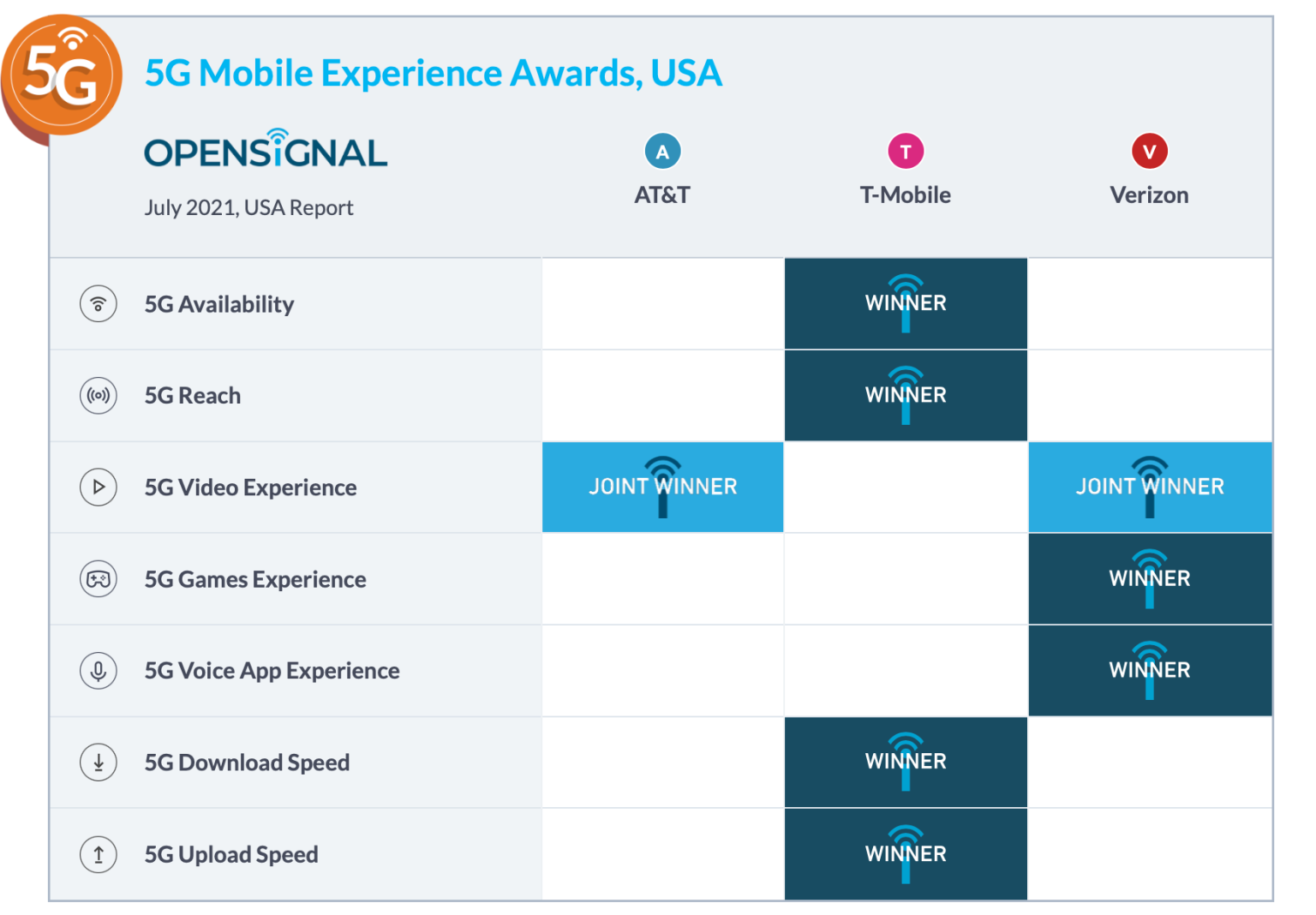OpenSignal reports shed light on 5G mmWave and 5G User Experiences
According to a new report, “Quantifying the mmWave 5G experience in the US — July update“ by OpenSignal, the average U.S. mobile user connects to a 5G millimeter wave (mmWave) network less than 1% of the time. The difference between AT&T, Verizon, and T-Mobile’s 5G mmWave network access is miniscule with Verizon customers at 0.7% of the time, AT&T’s at 0.4% of the time, and T-Mobile’s at 0.2% of the time. OpenSignal’s latest mmWave 5G report features data collected from March to June, 2021. The network monitoring company obtained its data from software installed in more than 100 million smartphones around the world, which send back anonymized usage data to OpenSignal on a daily basis.

Regarding 5G mmWave network speeds, T-Mobile users experienced the fastest average 5G mmWave network download speeds of 618.4 Mbps with Verizon, which was nearly twice as fast as users’ average experience on T-Mobile, and more than two and a half times faster than what our users experienced on AT&T. Verizon users continue to experience the fastest average 5G mmWave download speed which Opensignal has seen to date. Users’ average download speed on AT&T’s 5G mmWave was 245 Mbps, while we recorded an average 5G mmWave download speed of 312 Mbps on T-Mobile. AT&T and T-Mobile’s scores were statistically tied.
T-Mobile users experienced the fastest average 5G upload speeds on 5G mmWave networks with a score of 39.9 Mbps, which was 29.7-33.1% faster than what was observed on both AT&T and Verizon. Average upload speeds for AT&T and Verizon’s mmWave 5G services were 30 Mbps and 30.8 Mbps, respectively.
…………………………………………………………………………………………………………………………………………………………..
5G technology promised to support high-speed mobile operations in the mmWave spectrum bands, thus allowing operators to raise their peak network speeds from around 100Mbit/s to above 1Gbit/s. However, distance is extremely limited and line of sight connectivity is required. Transmissions in mmWave spectrum can’t travel more than a few thousand feet, and usually cannot penetrate through glass or trees. So many small cells close to the 5G mmWave user are needed which are often difficult to get permits for and install on public property (like street lights, lamps, rooftops, etc).
In contrast, wireless transmissions in traditional, lowband cellular spectrum bands, such as 800MHz or 1900MHz, can often travel miles and reach deep inside homes or office buildings.
Furthermore, ITU-R WP 5D has not agreed on the revisions of ITU-R M.1036 Frequency Arrangements for terrestrial IMT which MUST include (but do not now) the mmWave bands approved at WRC 19. Therefore, there is no standard for exactly what 5G mmWave frequencies should be used along with their duplexing and other arrangements.
………………………………………………………………………………………………………………………………………………………
In a companion report on 5G User Experiences, OpenSignal found that T-Mobile doubled its lead in the 5G Download Speed category. T-Mobile users saw average 5G Download Speeds of 87.5 Mbps, ahead of our users on AT&T and Verizon which both scored 52.3 Mbps. Our T-Mobile users’ average 5G Download Speed has increased by an impressive 16.3 Mbps compared to our April 5G report, and 29.4 Mbps compared to our January 5G report. By comparison, our users on AT&T saw their average 5G Download Speeds reduce by 2.7 Mbps since our last report, while our users on Verizon experienced a 4.5 Mbps improvement.
T-Mobile won the 5G Upload Speed award with a score of 15.1 Mbps, which is statistically unchanged compared to our previous report. Verizon places second showing an improvement of 1.2 Mbps and reaching 14.2 Mbps, while AT&T follows behind with 8.8 Mbps — a 1.2 Mbps decline since our April 2021 5G report.

SOURCE: OpenSignal
AT&T and Verizon shared the award for 5G Video Experience, scoring 61.3 points and 61.2 points, respectively. AT&T claimed the award in April 2021, while Verizon was the sole winner in January 2021. T-Mobile has placed third across all 5G Video Experience awards, this time scoring 54.8 points. Video Experience quantifies the quality of video streamed to mobile devices by measuring real-world video streams over carriers’ networks.
Finally, Verizon won the 5G Voice App Experience award scoring 83.3 points and moving past AT&T, which was the previous winner. Verizon has improved its score by 0.7 points since our previous report, while we have observed 0.6-0.8 points declines on both AT&T and T-Mobile. All three mobile operators place in the Good category (80-87 points). Voice App Experience measures the quality of experience real-time communications using over-the-top (OTT) voice apps. Examples of these types of apps include WhatsApp, Skype and Facebook Messenger.
References:
https://www.opensignal.com/2021/07/13/quantifying-the-mmwave-5g-experience-in-the-us-july-update
https://www.opensignal.com/reports/2021/07/usa/mobile-network-experience-5g
https://www.lightreading.com/5g/the-age-of-mmwave-5g-sputters-to-dusty-death/a/d-id/770838?


